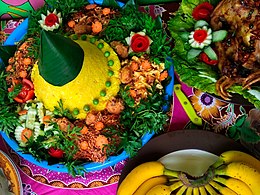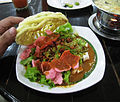Betawi cuisine

 |
| This article is part of the series on |
| Indonesian cuisine Masakan Indonesia |
|---|
|
|
Betawi cuisine is rich, diverse and eclectic,
History and influences

The Betawi cuisine developed and evolved with influences from various cuisine traditions brought by waves of newcomers to the port-city on the north coast of Western
Betawi cuisine is in fact really similar to
A gastronomy expert suggests that some Betawi dishes can describes the past condition of Betawi people reside in Batavia. For example, kerak telor was created due to the low quality of local glutinous rice, with the egg and other toppings added to make it more tasty and satisfying. Soto tangkar, which today is a meat soup, was mostly made from the broth of goat rib-cage bones in the past because meat was expensive, or the common population of Batavia were too poor to afford some meat back then.[1][6]
Today, many authentic Betawi dishes are hard to find even in its native land. This is partly because as a cosmopolitan city, Jakarta also features dishes from many far-flung parts of
Ingredients and cooking method

Betawi cuisine uses rice as staples, numbers of its dishes are revolved around rice, either steamed, cooked in coconut milk as
Popular Betawi dishes include soto betawi (beef offals in milky broth), sayur asem (sweet and sour vegetable soup), sop iga sapi (beef rib soup) and kerak telor (spiced coconut omelette). Most of Betawi dishes are cooked in deep-fried, stir-fried, barbecued or braised methods, and feature a delicate balance of sweet, sour and salty flavours.[2]
Dishes

- Asinan betawi, a salad made from a mix of pickled vegetables, yellow noodles and sweet, sour and spicy peanut sauce, topped with a handful of rice crackers.[2]
- Bakcang, glutinous ricestuffed with meat and wrapped in bamboo leaf in triangular (more precisely, tetrahedral) form.
- Bubur ayam (lit. chicken congee), rice congee with shredded chicken meat served with some condiments and cakwe.
- Empal, sweet and spicy fried beef dish
- Gado-gado, a kind of boiled or blanched vegetables salad in peanut sauce.
- Kerak telor (lit. egg crust), a glutinous rice cake cooked with egg and served with shredded coconut and a dried shrimp topping.
- Ketoprak, vegetables, tofu, rice vermicelli and rice cake in peanut sauce.
- Ketupat, rice dumpling made from rice packed inside a diamond-shaped container of woven palm leaf pouch.
- Ketupat sayur, ketupat compressed rice-cake in spicy vegetables in thin coconut milk soup.
- Lontong, pressed rice cake (dumpling) inside banana wrapping.
- Lontong cap go meh, lontong in rich coconut milk with chicken opor ayam, liver in chilli, sayur lodeh, and telur pindang (marbled egg)
- Lontong sayur, almost identical to ketupat sayur, but uses lontong instead.
- Laksa betawi, a Betawi laksa—the thick yellowish coconut milk based soup is a mixture of spices contains ground rebon or ebi (dried small shrimp), ketupat, vegetables, boiled egg, sprinkled with bawang goreng and often topped with emping cracker.
- water spinach.
- Nasi biryani, Betawi-style of biryani rice dish—flavoured rice dish cooked or served with vegetables, mutton or chicken meat.[8]
- Nasi goreng domba, spicy fried rice with mutton meat, cooked in ghee.
- Nasi goreng kambing, spicy fried rice with goat meat, cooked in ghee.
- .
- Nasi mandi, rice dish served with either roasted chicken, lamb or other meat.[9]
- Nasi tim, steamed chicken rice served with chicken broth soup.
- empalbeef and fried chicken.
- Nasi ulam, rice with vegetables with side dishes.
- Pecak gabus, spiced snakehead fish dish.[7]
- Perkedel, fried patties, made of ground potatoes, minced meat, peeled and ground corn or tofu, or minced fish.
- Pesmol, spiced fish dish, usually carp or milkfish.
- Pindang bandeng, milkfish cooked in dark color, sweet and sour soup.
- Pindang serani, a fish dish with vegetables from Marunda.
- Roti buaya (lit. crocodile bread), crocodile-shaped bread.
- Roti gambang (lit. xylophone bread), rectangular shaped brown bread with sesame seeds, flavored with cinnamon and palm sugar. Usually served during Ramadan and other Betawi occasion.
- Rujak juhi, vegetables with shredded dried squid in peanut sauce.
- Rujak shanghai, preserved seafood and jellyfish with vegetables and sweet and sour sauce.
- claypot.
- Sate kuah, beef satay served in rich and creamy spicy soup, akin to soto tangkar.
- pungent-smelling bean stewed in a sweet soy sauce.
- Sayur asem, vegetables in tamarind soup.
- Sayur besan, vegetarian dish made of Saccharum edule.
- Sayur papasan, mixed vegetable soup.
- Soto betawi, beef offal soup with diced tomatoes and slices of fried potato.
- Soto kaki, beef or goat leg tendons and cartilage soto.
- Soto mi, spicy noodle soup dish that consists of yellow noodles and soto soup.
- Soto tangkar, soto made of chopped beef ribs.
- Tahu goreng, fried tofu with peanut sauce or sweet soy sauce with chopped chili.
- bean sprouts and light soy sauceflavoured with oil.
- -based sauce
Snacks and desserts

- Bubur cha cha, dessert or breakfast dish made of pearled sago, sweet potatoes, yams, bananas, coconut milk, pandan leaves, sugar and salt. The ingredients are cooked in coconut milk, and the dish can be served hot or cold.
- Bubur sumsum, white congee made from rice flour and eaten with brown sugar sauce.
- Cakwe, cruller or fried long bread, served with sweet, sour and spicy dipping sauce.
- Cincau, grass jelly—jelly-like dessert.
- Dodol, a sticky confectionery made of coconut, glutinous rice and brown sugar
- Emping, bite-size snack kripik cracker, made of Gnetum gnemon nuts (which are seeds). Emping crackers have a slightly bitter taste.
- sweetsmade from sugar and grated coconut.
- Kembang goyang (lit. shaking flower), traditional snack made of rice flourwhich is mixed with eggs, sugar, a pinch of salt and coconut milk. The dough can be fried after heating the oil and the kembang goyang mold.
- Kue ape, a soft-centered cake with a flimsy but crisp crust.
- Kue cubit (lit. pinch cake), traditional pancake that uses flour, baking powder, sugar and milk as its primary ingredients. This cake is related to poffertjes.
- Kue cucur, a pancake made of fried rice flour batter and coconut sugar.
- Kue gemblong, a rice flour dough covered in sticky brown coconut sugar.
- Kue ku, a small round or oval-shaped pastry with soft sticky glutinous riceflour skin wrapped around a sweet filling in the centre.
- Kue pancong, a sweet coconut hot cake.
- Kue pepe, a sticky, sweet layered cake made of glutinous rice flour.
- Kue putu, traditional cylindrical-shaped and green-colored steamed cake.
- Kue putu mayang, idiyappam-like rice noodles with a mixture of coconut milk and served with liquid palm sugar.
- Kue rangi, coconut waffle served with thick brown coconut sugar.
- Kue talam (lit. tray cake), traditional cake made of rice flour, coconut milk and sugar steamed in cake mold or cups.
- jicama and served with spicy peanut sauceas a dipping sauce.
- Pastel de nata, an egg tart pastry dusted with cinnamon from Kampung Tugu—derived from Portuguese cuisine.
- Semprong, wafer snack made by clasping egg batter using an iron mold (waffle iron) which is heated up on a charcoal stove.
- Wajik, diamond-shaped compressed sweet glutinous rice cake.
Beverages
- Bir pletok, a non-alcoholic drink made from the bark of the secang tree.
- Cendol, an iced sweet dessert that contains droplets of green rice flour jelly, coconut milk and palm sugar syrup.
- Es cincau, grass jelly drink served with shaved ice, coconut milk and sugar.
- Es selendang mayang, a sweet iced dessert made of kinca or liquid pandan leaf for aroma, ice and cakes made of glutinous rice flour or hunkwe (mung beansstarch powder).
- Sekoteng, a warm beverage made of ginger and milk, poured with peanut, cubed bread, and pacar cina (tapioca pearls).
Gallery
-
Asinan betawi, pickled vegetables in peanut sauce.
-
Gado-gado, vegetables in peanut sauce.
-
Kerak telor, spicy coconut omelette.
-
Ketoprak, vegetables, tofu, rice vermicelli and rice cake in peanut sauce.
-
Ketupat sayur, ketupat rice cake in spicy vegetables soup.
-
Laksa Jakarta style.
-
Mie kangkung, noodle with water spinach.
-
Nasi goreng kambing (goat meat fried rice) Kebon Sirih
-
Nasi ulam Betawi.
-
Sayur asem Betawi version.
-
Soto betawi, a Betawi beef meat and offals in rich and creamy milk or coconut milk soup.
-
Soto kaki cow's foot tendons and cartilage soto, a Betawi specialty
-
Roti buaya, crocodile-shaped bread is often served in festive occasions.
-
Roti gambang, xylophone-shaped bread with sesame seeds.
-
Nasi kebuli with goat meat.
See also
References
- ^ a b c d e Maria Endah Hulupi (22 June 2003). "Betawi cuisine, a culinary journey through history". The Jakarta Post. Archived from the original on 14 September 2015. Retrieved 30 January 2015.
- ^ a b c Petty Elliott (23 June 2011). "Food Talk: In the Salad Days of Betawi Cuisine". Jakarta Globe. Archived from the original on 14 September 2015. Retrieved 30 January 2015.
- ^ a b Indah Setiawati (8 November 2013). "Weekly 5: A crash course in Betawi cuisine". The Jakarta Post. Archived from the original on 5 March 2016. Retrieved 5 August 2016.
- ^ "Nasi Kebuli Gaya Betawi". Kompas (in Indonesian). 21 February 2009. Archived from the original on 28 April 2023. Retrieved 30 January 2015.
- ^ "'Cipratan' Luar Ke Dalam" (in Indonesian). Femina. Archived from the original on 24 September 2015. Retrieved 1 February 2015.
- ^ Suryatini N. Ganie
- ^ a b Ayu Cipta (19 October 2014). "Preserving Betawi Traditional Cuisine". Tempo. Archived from the original on 10 February 2015. Retrieved 30 January 2015.
- ^ "Sajian Kebuli, Mandi, dan Biryani". 6 July 2014. Archived from the original on 27 June 2020. Retrieved 24 June 2020.
- ^ Mama Sya. "Nasi Mandhi@Mandy & Ayam Bakar". Photo Blog, Fotopages, October 07, 2009. Archived from the original on June 30, 2016. Retrieved June 24, 2020.
External links
 Media related to Betawi cuisine at Wikimedia Commons
Media related to Betawi cuisine at Wikimedia Commons


















